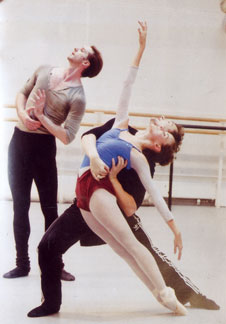Viscera, contemporary at its best
by Gwen Herat from the Royal Opera House, London
I love this incredible human continuity they place before the
audience, the quality that binds them together in one great sweep of
movements, boisterous, loud and clear. That is the essence of
contemporary dance the young have come to appreciate over the formal
basics of classical ballet. The emergence of this style of dance caught
like fire, fanning across the UK and the USA. But what I see today is
not what I saw Martha Graham of the New York City Ballet popularised
about 20 years ago.
Today's choreographers look at contemporary the way they wish to, in
keeping with music of today, sparsely played. In the hands of the
choreographer, the dancer is an instrument of boundless style,
capabilities with no limitations, and is transmitted to the audience.
Today, they dance to jazz and other popular modern scores that the
younger audience is more familiar with than for example, a Tchaikovsky
suite that we identify in ballet.
 |
|
Just before stepping on stage Meeghan
Grace Hinkis and Tristan Dyer in Royal Ballet's Viscera at
the Royal Opera House. |
Viscera is an exciting moment, full of tension and the unexpected as
this ensemble of large number of dancers, spit vitality and athletic
movements, dressed only in skin coloured tights. They are tall, svelte
and lissom and one cannot separate the boys from girls. They are like a
flowing river gushing in gentle waves, circling and back to centre
stage, suddenly with spectacular stuccato steps bringing down the roof
in a mighty crescendo.
These acts mirror the state of contemporary dance with the increasing
emphasis on technical virtuosity and visual spectacle. They dazzle with
extravaganza along with splendour and ingenuity just on a plain blank
stage. Their artistic merit is based on simple, calculated music as they
dance the steps. They are wearing pointers but seldom use them. This is
another merit in this short ballet Viscera. The girls do not manipulate
steps in accordance to the score but there is a clear uniformity as they
melt one with another, like a slithering snake.
There is nothing pretentious in their artistic endeavour though they
project a nude appearance through their skin-coloured tights.
Freedom of movement
Viscera is an emergence from very modern technique which
choreographer, Liam Scarlet lay emphasis on. The artistic fulfilment
they derive together, is the secret behind Viscera. Scarlett allows the
freedom of movement in the event one misses keeping close together which
I too witness from where I am seated. But the ensemble is so
professional, they let go such little mistakes while the others quickly
correct and fall in line.
A part of their effort to strip away from artificial decadence and
allure is strongly captivated in what they present just now but they
appear to upkeep the fundamental principles of movements as the base of
their dance techniques. It is because the Viscera team is so very
professional. Presented by the Royal Ballet and boarded at the Royal
Opera House, the whole audience including me, braved the extreme weather
to find our seats, running inside to beat the equally harsh rain. But it
is worth the inconvenience.
Choreographer
Liam Scarlet, choreographer is the youthful choreographer,. Naturally
with young ideas growing with dancing, going through the reforms on his
way up he is the icon behind Viscera's success. Instead of
choreographing from his seat, he dances with his team and becomes one of
them.
This gives more confidence to the dancers even if they are
professionals with the Royal Ballet.
Born in Ispwich he went through his early days under Linda Shipton
School of Dancing and then to the Royal Ballet Lower School. Graduated
in 2005 at the Royal Ballet and immediately promoted as First Artist in
2008, he won the Kenneth MacMillan and Ursula Moreton Choreographic
awards and thereafter, there was no stopping his high profile career.
He created Vayamos Al Diablo for the Royal Ballet as well as for the
Royal Opera House. In 2009 he joined the New York Choreographic
Institute at their invitation and created Gargoyles for the New York
City Ballet.
 |
|
Leticia Stock and Nehemia Kish going
through their duet before going on the stage with Liam
Scarlet, their choreographer in Viscera. |
His main stage-work for the Royal Ballet was Asphodes Meadows in 2010
and was nominated for the Southbank Award.
At present he is freelancing with many major ballet companies around
the world, mostly on contemporary as well as with classics. He considers
Viscera to be really a creative act and no one will disagree.
Lowel Liebermann, the composer is a great hit with popular recording
companies. Liebermann picks on soloists for recording.
His flute concert performed by James Galway at the London Mozart
players conducted by the composer himself, netted in record income. He
has written two operas.
The picture of Dorain Gray commissioned by the Monte-Carlo Opera and
Miss Lonelyhearts by the Julliard School to celebrate their 100th
anniversary. Liebermann has been the resident composer with the Dallas
Symphony Orchestra. He has performed at the Carnegie Hall, Lincoln
Centre, Wigmore Hall and the Berlin Philharmonic.
Credits
This year, he joined the Mannes American Composers Ensemble and was
exposed to the works of living American composers. In Viscera he
conducts solo piano of Robert Clerk.
Presented by: The Royal Ballet (males) Nehemiah Kish (females)
Choreography: Liam Scarlet Alexander Campbell
Music: Lowel Liebermann and Tristan Dyer
Costume: Liam Scarlet and Sander Blomaert
Lighting Design: John Hall and Donald Thom
Asst. Choreographer: Richardo Cervera David Trzensimiech
Dance Notator: Amanda Eyles
Ensemble-Cast: Laura Morera, Leticia Stock, Yuhui Choe, Meaghan
Grace, Emma Maguire, Olivia Cowley, Claudia Dean, Natahlie Harrison,
Elizabeth Harrod and Yasmin Naghadi .
|



